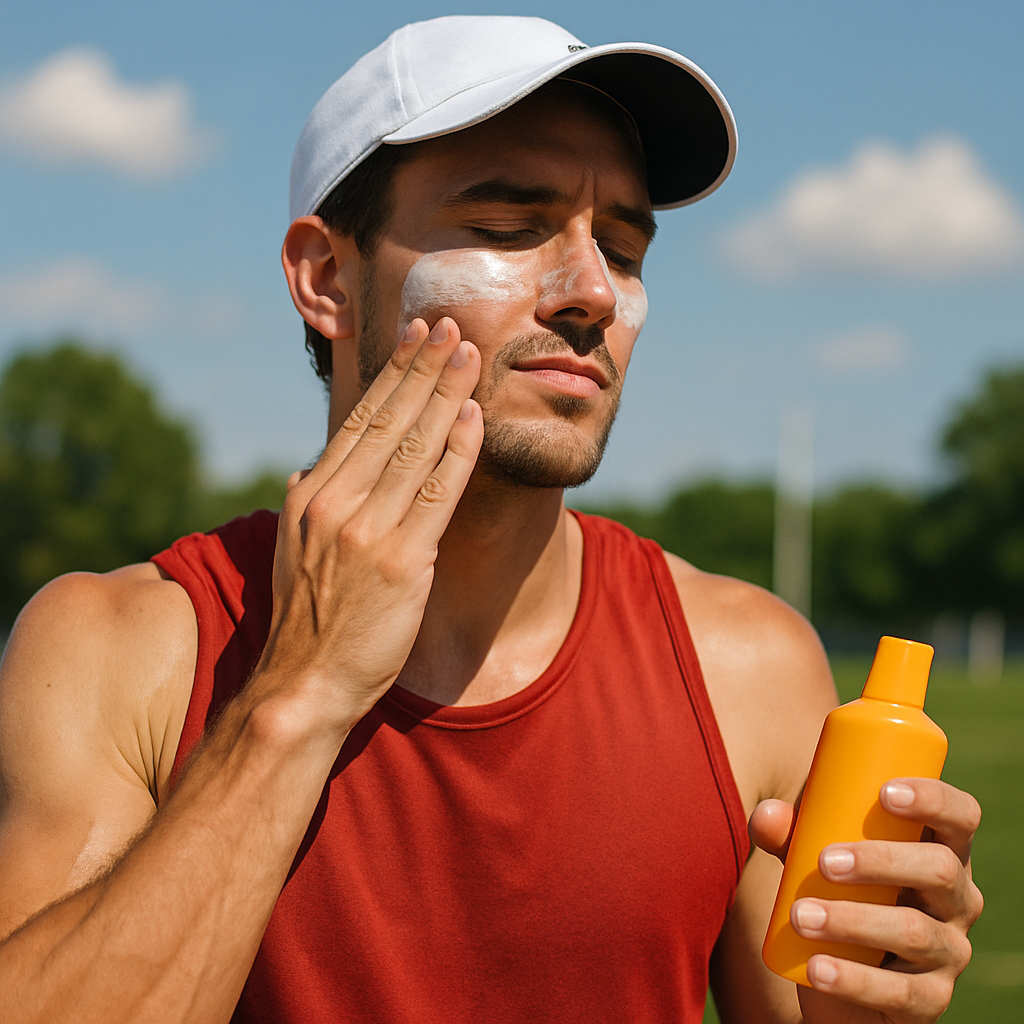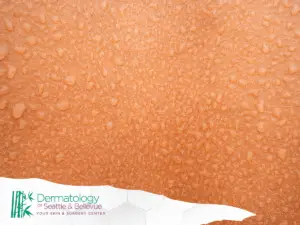Athletes deal with unique skin challenges—from chafing and heat rash to fungal infections, sun exposure, and irritation caused by sweat, friction, and outdoor training. A strong skincare routine for athletes focuses on hydration, cleansing, moisture balance, and UV protection. Adding preventative strategies like UV protection clothing, early fungal infection treatments, and proper recovery habits can help keep skin resilient through intense workouts. At Dermatology of Seattle, our dermatologists help active patients manage sports dermatology concerns and prevent long-term damage. With the right habits and early intervention, you can avoid common issues and keep your skin healthy while staying competitive.
What Skin Challenges Do Athletes Face Most Often?
Athletes deal with friction, moisture buildup, sun exposure, and repeated environmental stress. These factors increase the risk of chafing, heat rashes, fungal infections, and irritation.
The combination of sweat, tight clothing, and prolonged activity makes athlete skin care very different from a typical routine. Friction can lead to chafing; trapped moisture encourages fungal overgrowth; and long outdoor practices expose the skin to UV damage. Knowing these risks helps you stay proactive and prevent downtime from skin-related issues.
Why Are Hydration and Nutrition Key for Athlete Skin Health?
Hydration supports elasticity, barrier strength, and recovery. Proper nutrition helps skin repair damage, maintain resilience, and prevent irritation.
How Does Hydration Improve Skin Resilience?
Hydration keeps your skin elastic, healthy, and better able to withstand friction from sports gear. When you’re dehydrated, the skin becomes dry and more prone to cracking, irritation, and injury. Drinking water consistently supports overall skin health and helps the skin function at its best.
What Nutrients Support an Athlete’s Skin?
A diet rich in vitamins C, E, zinc, and antioxidants boosts collagen production, healing, and repair. Foods like berries, citrus fruits, leafy greens, and nuts help neutralize free radicals and reduce inflammation. This nutrition-first approach makes the skin more resilient during intense training.
How Should Athletes Cleanse and Moisturize Their Skin?
Use gentle cleansing to remove sweat and bacteria, followed by lightweight hydration to prevent clogged pores and irritation.
Cleansing for Active Lifestyles
Sweat mixes with oil, dirt, and bacteria—especially under helmets, pads, or tight clothing. Athletes should use a mild, non-stripping cleanser to remove impurities without weakening the barrier. This reduces breakouts and helps prevent skin irritation remedies from becoming a necessity later.
Moisturizing Without Clogging Pores
Use a lightweight, non-comedogenic moisturizer to balance hydration after cleansing. Even oily or sweaty skin needs moisture to stay healthy. Moisturizers protect your barrier, reduce irritation, and keep the skin flexible enough to handle constant movement.
Why Are Regular Skin Checks Important for Athletes?
Frequent self-checks help catch irritation, infections, and unusual changes early—especially important for outdoor athletes with high sun exposure.
Athletes should look for new spots, changing moles, or persistent irritation. If you’re regularly outdoors, UV exposure increases the risk of skin cancer over time. A dermatologist can help monitor concerns, recommend UV protection clothing, and provide tailored advice for keeping your skin safe during training and games.
Sports Dermatology: Common Issues
Common athlete skin issues include chafing, fungal infections, heat rashes, and sun-related damage. These problems stem from friction, moisture, sweat, gear, and outdoor exposure.
Active lifestyles expose the skin to constant movement, sweating, and environmental stress. Recognizing early signs of irritation helps prevent complications and keeps you performing at your best.
How Can Athletes Prevent and Treat Chafing?
Reduce friction with moisture-wicking fabrics, anti-chafe balms, and breathable clothing. Treat chafing by cleansing gently and applying soothing barrier ointments.
Why Does Chafing Happen?
Chafing develops when skin rubs against skin or tight clothing—especially in humid or sweaty environments. Areas like the thighs, underarms, and nipples are usually hit hardest.
How to Prevent Chafing
- Wear moisture-wicking fabrics
- Apply a lubricant or anti-chafe balm before training
- Keep skin dry and clean
- Choose well-fitted athletic gear
These strategies help minimize friction and prevent irritation before it starts.
How to Treat Chafing
If chafing does occur:
- Clean the area gently with mild soap and water
- Apply petroleum jelly or a soothing ointment
- Avoid further friction until healing improves
- Wear loose, breathable clothing during recovery
This supports healing and protects against infection.
How Can Athletes Prevent Fungal Infections?
Fungal infections thrive in warm, moist environments. Keep skin dry, change out of sweaty clothes quickly, and use early antifungal care when needed.
Why Are Fungal Infections So Common in Sports?
Conditions like athlete’s foot and jock itch spread quickly in sweaty gear, locker rooms, and tight athletic clothing. Without proper prevention, fungi have the perfect environment to grow.
Prevention Tips for Fungal Infections
- Shower promptly after workouts
- Dry feet, groin, and skin folds thoroughly
- Wear breathable, loose clothing
- Avoid staying in damp workout gear
- Use foot powders to reduce moisture
When to Seek Treatment
Mild infections often improve with over-the-counter fungal infection treatments, but persistent rashes or itch require prescription medication. Dermatologists can also rule out look-alike conditions like eczema or psoriasis.
How Should Athletes Protect Their Skin From Sun Exposure?
Use UV-blocking clothing, broad-spectrum sunscreen, and after-sun hydration to prevent long-term damage.
Outdoor athletes face higher UV exposure than they realize—even on cloudy days. Sun protection is essential for preventing premature aging, hyperpigmentation, and skin cancer.

How Does UV Protection Clothing Help?
UV protection clothing with a UPF rating shields the skin from UVA and UVB rays without sweating off like sunscreen. Long sleeves and full-length pants are great options for extended training sessions.
(Internal linking cue: link to “sun safety tips” or “skin cancer screening” services.)
Sunscreen Tips for Athletes
- Choose SPF 30 or higher
- Use water-resistant, sweat-friendly formulas
- Reapply every 2 hours—or sooner if sweating heavily
- Cover easy-to-miss spots like ears, neck, and feet
Sunscreen helps protect against sunburn, hyperpigmentation, and cumulative UV damage.
After-Sun Care
Post-sun hydration helps repair the barrier and soothe irritated areas. Aloe vera or cooling gels reduce discomfort and help restore moisture. Monitor your skin for new moles or changes—early detection is key for maintaining long-term skin health.
What Skincare Routine Should Athletes Follow Daily?
Athletes need a simple, consistent routine focused on cleansing sweat away, restoring hydration, and protecting the skin from UV exposure, friction, and moisture buildup.
Morning Routine: Cleanse, Moisturize, Protect
A strong morning routine sets the tone for the day:
Cleanse:
Use a gentle cleanser to remove oils that build up overnight. This helps prep your skin for sweat, movement, and outdoor exposure.
Moisturize:
Apply a lightweight, non-comedogenic moisturizer to maintain hydration without clogging pores.
Protect:
Use broad-spectrum sunscreen (SPF 30+) or rely on UV protection clothing before heading outside. This prevents sunburn, hyperpigmentation, and long-term damage.
What Should Your Post-Workout Skincare Routine Look Like?
Post-workout care is essential—sweat, bacteria, and friction can trigger breakouts, fungal infections, and irritation.
Cleanse Immediately After Exercise
Shower as soon as possible to remove sweat, bacteria, and dirt. This prevents clogged pores, fungal overgrowth, and odor-causing buildup.
Restore Hydration
Reapply a light moisturizer to replenish water lost through sweat and heat. Even oily skin needs hydration to stay balanced.
Use Targeted Treatments
If you’re prone to fungal infections or irritation, apply antifungal creams or soothing products to vulnerable areas. Early treatment prevents mild issues from becoming chronic.
What Should Athletes Do Before Bed for Healthier Skin?
Nighttime is your skin’s repair window—cleanse, moisturize, and treat trouble spots to support recovery.
Evening Routine Essentials
Cleanse:
Wash away sweat, dirt, sunscreen, and environmental pollutants that collect throughout the day.
Moisturize:
Use a richer moisturizer to support overnight repair and barrier recovery.
Repair:
Treat chafing, sunburn, or irritation with soothing products recommended by a dermatologist. Addressing issues early helps skin heal faster and reduces downtime.
What Are the Best Solutions for Heat Rash in Athletes?
Wear loose, breathable clothing, keep skin cool and dry, and use soothing topicals like calamine or hydrocortisone when needed.
How to Prevent Heat Rash
Heat rash develops when sweat ducts become blocked—a common issue during intense workouts, hot weather, or humid environments. Prevent it by wearing breathable fabrics like cotton or moisture-wicking athletic wear.
How to Treat Heat Rash
To soothe irritation:
- Keep the area cool and dry
- Take breaks from heat exposure
- Apply calamine lotion or hydrocortisone
- Avoid heavy creams that can trap sweat
These steps reduce inflammation and help the skin return to normal more quickly.
Conclusion
Athlete skin care isn’t just about appearance—it’s an essential part of staying healthy, comfortable, and able to perform at your best. Your skin works just as hard as your muscles, protecting you from friction, heat, sweat, bacteria, and the sun. By building a simple, proactive routine and understanding common issues like chafing, fungal infections, sun exposure, and heat rash, you can keep your skin resilient through every workout and competition.
If you’re dealing with persistent irritation, recurring infections, or sports-related skin issues, the dermatologists at Dermatology of Seattle (Seattle, Bellevue, and Burien) can help you create a personalized plan that fits your training schedule and skin needs.







